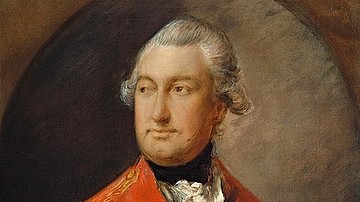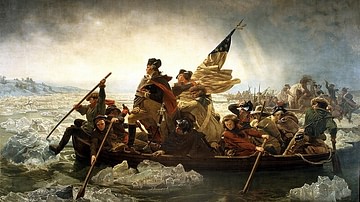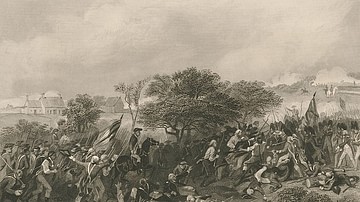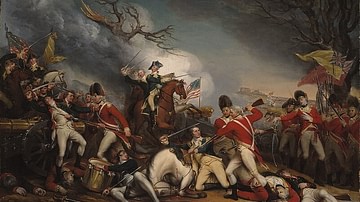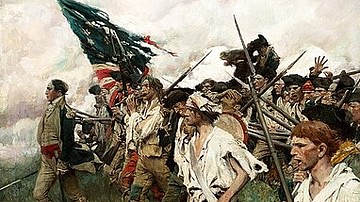The Battle of Trenton (26 December 1776) was an important battle of the American Revolutionary War (1775-1783). On Christmas Day 1776, General George Washington led his Continental Army across the Delaware River to launch a surprise attack against the Hessian garrison of Trenton, New Jersey, the next morning. The resulting American victory galvanized renewed support for the American Revolution (1765-1789).
In early December 1776, General Washington and the Continental Army were chased across the Delaware River and into Pennsylvania after suffering a series of disheartening defeats in the New York and New Jersey Campaign (July 1776 to January 1777). By this point, the British army under General William Howe had seized Long Island and New York City, occupied Manhattan, and had begun to reassert royal authority in the resource-rich state of New Jersey. Meanwhile, Washington's army had been reduced by desertion and disease to barely 3,000 men, with more enlistments set to expire in the new year. His second-in-command, General Charles Lee, had been captured, and the Second Continental Congress had been forced to evacuate the nation's provisional capital of Philadelphia. If Washington did not decisively act, his army was likely to disintegrate over the winter months, and the United States of America, not yet half a year old, would be destroyed.
For this reason, Washington led his army in a daring crossing back over the icy Delaware on Christmas Day 1776, moving back into New Jersey. He knew that the town of Trenton was garrisoned by a battalion of Hessians, professional German soldiers who fought for Great Britain, and gambled that the Hessians would be taken by surprise after their Christmas celebrations. His gamble paid off; after a short skirmish on 26 December, the Americans defeated the Hessians, taking 900 of them prisoner without losing a single American life in battle. The Battle of Trenton, coupled with another American victory at the Battle of Princeton (3 January 1777), ensured that New Jersey did not fall into British hands, and led to renewed enthusiasm for the war. Many Patriots were inspired by the victories to enlist in the Continental Army, allowing it to survive and carry on the war.
Crisis
In late November 1776, the ragged Continental Army trudged down the muddy roads of New Jersey toward Newark. Its troops were hungry, footsore, and sick. Many of them went unshaven and unclothed, forced to march without coats or shoes through sleet and driving rain. Men were leaving the army in droves; some left because their enlistments had expired, while others simply deserted, having abandoned the American cause as lost. It is not difficult to see why they believed so: the Continental Army had been in a state of near-constant retreat since its first major defeat at the Battle of Long Island (27 August 1776). Since then, the Americans were pushed first out of New York City, then out of Manhattan altogether; all the while, they suffered a string of disheartening battlefield defeats at Kip's Bay (15 September), White Plains (28 October) and, most notably, at the Battle of Fort Washington (16 November), in which 2,800 desperately needed Continental troops were taken prisoner, most of them destined to die abysmal deaths aboard Britain's infamous prison ships.
Just before the loss of Fort Washington, the Continental Army had split in two; General George Washington led 3,500 soldiers across the Hudson River and into New Jersey, leaving 5,500 men at North Castle, New York, under his second-in-command, General Charles Lee, to keep the British from advancing further north toward Albany. On 20 November, British General Lord Charles Cornwallis followed Washington across the Hudson and captured Fort Lee on the New Jersey Palisades mere hours after the Americans had abandoned it. With 10,000 British and Hessian soldiers under his command, Lord Cornwallis set out in pursuit of Washington's army, intending to corner and capture it in much the same way that "a hunter bags a fox" (McCullough, 253).
On 22 November, when Washington entered Newark, he realized it had been a mistake to divide his forces and wrote a letter to General Lee, entreating him to cross the Hudson so they could join forces. Washington, however, made the mistake of requesting Lee's assistance, not ordering it, and Lee did not bother to stir himself from North Castle. Citing foul weather and ill-equipped men, the English-born Lee truthfully detested having to take orders from Washington, a provincial whom he blamed for the loss of Manhattan; Lee hoped to wait and find a chance to win the glory for himself so Congress would offer him Washington's job. On 27 November, once Washington learned that Lee was not coming, he hesitantly left Newark, continuing his retreat toward New Brunswick and the Raritan River, with Cornwallis in close pursuit. Around this time, Washington received more dire news: the Second Continental Congress had evacuated the provisional capital of Philadelphia and moved to Baltimore, Maryland; this development did nothing to inspire confidence in his men.

On 1 December, Washington crossed the Raritan, burning the one bridge over the river after he had crossed, and leaving an artillery battery under a young Captain Alexander Hamilton to cover the army's retreat. That same day, the enlistments of nearly 2,000 Virginia and Maryland troops expired, with almost all of them refusing to sign on again. It was a bleak situation. Even Washington, famous for his stoic and aristocratic demeanor, was ridden with anxieties, and for a moment regretted ever agreeing to take command. Thomas Paine, whose influential pamphlet Common Sense had helped inspire American independence, was now serving as a staff officer in the Continental Army and recorded his thoughts in another pamphlet entitled The Crisis. The opening lines read:
These are the times that try men's souls. The summer soldier and the sunshine patriot will, in this crisis, shrink from the service of their country; but he that stands it now, deserves the love and thanks of man and woman. (McCullough, 251)
Meanwhile, General Lee had finally been induced to move and crossed the Hudson. But rather than march to join up with Washington, Lee hung back, hoping to find an opportunity to attack the British rear. On the night of 12 December, Lee made the mistake of sleeping in a tavern over three miles away from where his army was encamped. When a party of British officers under the soon-to-be-infamous Lieutenant Banastre Tarleton happened upon the tavern, the defenseless Lee was captured, still in his nightgown. General John Sullivan assumed command of Lee's army and immediately marched to link up with Washington.
Winter Quarters
But even with the addition of Sullivan's forces, Washington knew his army was in no state to take on Cornwallis. The retreat had to continue, and, in early December, the demoralized Continental Army crossed the Delaware River and entered Pennsylvania. Here, their numbers were boosted when they were joined by General Sullivan's 4,000 men and an additional 1,000 under General William Alexander, better known as Lord Stirling. While these reinforcements were welcome, Washington only had a limited time to make use of them; more enlistments were set to expire in the new year and, unless conditions improved or a victory was won, most of the men would surely choose to go home. Washington knew he had to recross the Delaware and attack before then, since even defeat was preferable to doing nothing. The only question was when he should strike.
Meanwhile, the British had called off their pursuit. After the British artillery had exchanged fire with Captain Hamilton's guns and chased them off, Cornwallis' troops had forded the Raritan and occupied New Brunswick. However, Cornwallis was disinclined to follow Washington into Pennsylvania; traditionally, European armies did not fight in the winter unless absolutely necessary, and it was about time to settle into winter quarters. Sir William Howe, Cornwallis' superior, agreed. While Howe is often accused of caring more about spending time with his charming 24-year-old mistress, Elizabeth Loring, than catching Washington, he had good reason to suspect that Washington's rapidly disintegrating army would not last the winter; why waste the lives of British troops to accomplish something that a miserable winter would take care of anyway? So, from his headquarters in New York City, Howe ordered the British army into winter quarters.
Most of the British soldiers pulled back to winter in New York City, leaving a thin line of British and Hessian troops to occupy New Jersey. A proclamation issued by Howe promised pardons to any American who submitted to Britain, causing hundreds of New Jersey residents a day to show up at British military camps to swear allegiance to the king. But while Howe hoped to bring New Jersey back into the fold by offering reconciliation, these attempts were undermined by his Hessian soldiers, troops that Washington had once described with contempt as "base hirelings and mercenaries" (Middlekauff, 349). As hired soldiers, the Hessians did not care for political sensitivities and behaved much like occupying soldiers often do, by terrorizing local farmers and taking what they pleased. For this reason, the Hessians earned the hatred of the locals and often became targets for partisan attacks; historian Robert Middlekauff writes that Colonel Johann Rall, commander of the Hessian garrison at Trenton, had to send a patrol of 50 men just to escort a letter to Cornwallis' headquarters at Princeton.
Crossing the Delaware
With Hessian battalions occupying the British forward positions in a thin line from Trenton to Burlington, and considering the amount of hatred they had stirred up, it made sense for Washington to target them. His plan was to make a night crossing of the Delaware River, strike the Hessian garrison at Trenton, and melt away before the British could retaliate. He planned to make the crossing in three parts: General James Ewing would lead 700 men over the Trenton Ferry to seize the bridge at Assunpink Creek, just to the south of Trenton; General John Cadwalader would cross with a second 1,500-man force further downriver at Bristol to cut off the Hessian retreat to Burlington; and Washington himself would lead the main force of 2,400 men across the Delaware at McKonkey's Ferry, 9 miles (15 km) upstream from Trenton, to assault the town itself. Hoping to catch the Hessians by surprise after their Christmas celebrations, Washington planned to cross the Delaware on Christmas Day.
But Christmas saw a sudden and freezing storm that soon turned into a nor'easter. The Delaware was overflowing and coated with sheets of ice while snow, hail, and rain fell in droves, but Washington was determined not to call off his attack. Dr. Benjamin Rush, a delegate from the Continental Congress, was visiting Washington that day and would later recall that the general, in a dark mood, kept scribbling something on small scraps of paper with his pen. When one piece of paper fell on the floor, Rush was able to read it: "Victory or Death" (McCullough, 273), a phrase that was to be the night's password. When dark fell, Washington lined his troops up at McKonkey's Ferry and, at midnight, the men were loaded up in flatbottom boats and began to cross. Through the howling wind of the storm, it was difficult for men to hear one another, and it soon fell to Brigadier General Henry Knox, whose deep, bellowing voice cut through the wind, to take charge. As Knox loaded the men, and his 18 field guns, onto the boats, Washington crossed the river early with a group of officers including John Sullivan, Nathanael Greene, and Lieutenant James Monroe (a future US president).

It was 4 a.m. before all 2,400 of Washington's men had crossed the river, well behind schedule. Still, they had fared better than the other two groups; both Ewing and Cadwalader had called off their crossings due to the weather. Disappointed by this news, Washington decided to press on with the attack anyway. He formed his men into two columns: General Greene would lead the first one down the upper road, while General Sullivan marched down the lower road, thereby approaching Trenton from two sides at once. The men, freezing and drenched in river water, then marched into the night. Aside from the faint light emanating from a few lanterns, the march was conducted totally in the dark, with men fighting not to succumb to the bitter cold. Two men would freeze to death that night, with one other soldier recounting his experience:
I recollect very well that at one time, when we halted on the road, I sat down on the stump of a tree and was so be-numbed with cold that I wanted to go to sleep. Had I been passed unnoticed, I should have frozen to death without knowing it. (McCullough, 277)
After the long and harrowing march, both columns of Continental troops arrived in position outside Trenton at roughly the same time, a few minutes after 8 a.m. on 26 December.
The Battle
Trenton was a small town described by writer David McCullough as consisting of "perhaps a hundred houses, an Episcopal Church, a marketplace, and two or three mills and iron furnaces" (278). Most of its residents had long since fled, abandoning their town to a battalion of 1,500 Hessian soldiers under the command of Colonel Johann Gottlieb Rall, a 56-year-old German officer lauded for his actions at the Battle of Fort Washington a month earlier. Though Colonel Rall was known to enjoy drinking and playing cards, there is no evidence that he was drunk on the morning of the battle, as his detractors would later suggest. But the Hessians did have little regard for the ragtag Continental Army, a bias that led Rall to dismiss intelligence he received on the 24th that the Americans were planning to attack Trenton. Moreover, the Hessians had let their guard down as they indulged in Christmas celebrations.
At 8 a.m., Washington gave the order, and General Greene's column of troops charged out of the woods. As Henry Knox later recalled, the storm continued with "great violence", but the wind was at the Americans' backs and was therefore blowing snow and rain into the faces of the Hessian sentries who stood guard along the road (McCullough, 280). For this reason, the sentries could not make out how many Americans were rushing toward them and stood their ground until the sound of the roaring wind was broken by the crackle of American musket fire. The Hessians returned fire and, with great discipline, began retreating back toward the town, but Greene's troops maintained a steady suppressing fire. In the town of Trenton itself, drums began to beat as confused, half-dressed Hessians rushed out of their makeshift barracks. They were greeted by General Knox's artillery, which had been set up on both of Trenton's main streets.
The American cannons tore into the Hessians, killing or maiming several of them; when their comrades turned to flee, they were stopped by General Sullivan's men, running toward them with bayonets fixed. This led to fierce hand-to-hand fighting before the bewildered Hessians began throwing down their arms. Colonel Rall, who had just emerged from his quarters, barely had time to order his men to fall back to a nearby orchard before he was shot and mortally wounded. The Hessians dutifully fell back to the orchard and even brought out a cannon of their own. But the cannon was successfully seized by a company of Virginians under Lieutenant Monroe, bringing an end to the fighting, as the Hessians in the orchard quickly surrendered. In less than an hour of fighting, 21 Hessians had been killed (including Rall), and 90 had been wounded, with a further 900 having been taken captive. Except for the two soldiers who had frozen to death the night before, no Americans lost their lives and only four (including Monroe) were wounded. Although 500 Hessians had escaped across Assunpink Creek, it was an astounding victory for the Americans.
Aftermath
Immediately after his victory, Washington took his men, prisoners, and captured ammunition and marched back across the Delaware. He remained in Pennsylvania just long enough to gather the forces that had previously been unable to cross before moving back across the Delaware for a third time and marching back into Trenton. The unexpected victory had greatly boosted morale, and many troops whose enlistments were due to expire in January were induced to stay on for another six months; the deal was sweetened by Washington's promise of an extra ten dollars to each man who stayed. Although the Battle of Trenton was little more than a skirmish in terms of size, it had a massive effect; Patriot newspapers hailed it as a great victory, proof that the American cause was far from dead. The victory also proved that if the Continental Army remained intact, the United States had a chance at securing independence, leading to increased recruitment in the weeks following the battle.

For Washington, the danger was not yet over. As long as the British maintained a presence in New Jersey, his task was not yet complete. On 3 January 1777, he launched another surprise attack against Lord Cornwallis' rearguard at the Battle of Princeton, which resulted in another American victory and caused Howe to withdraw his troops from New Jersey. Washington's victories at Trenton and Princeton, therefore, prevented New Jersey from falling into British hands and ensured the survival of the Continental Army, which would keep on fighting for the next seven years.





